Call of Duty 5: WaW theme by InvincibleSIKH
Download: CallofDuty5WaW.p3t
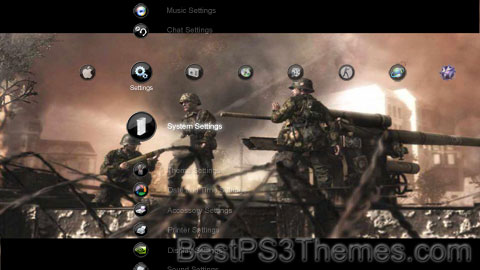
(3 backgrounds)
Redirect to:

The #1 spot for Playstation themes!
Call of Duty 5: WaW theme by InvincibleSIKH
Download: CallofDuty5WaW.p3t

(3 backgrounds)
Redirect to:
Kira theme by darkliam
Download: Kira.p3t
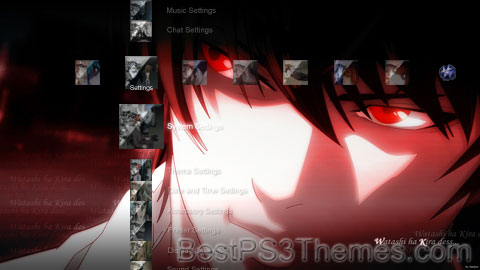
(5 backgrounds)
Kira may refer to:
LittleBigPlanet theme by Tony G. (mr_billionaire)
Download: LittleBigPlanet_18.p3t
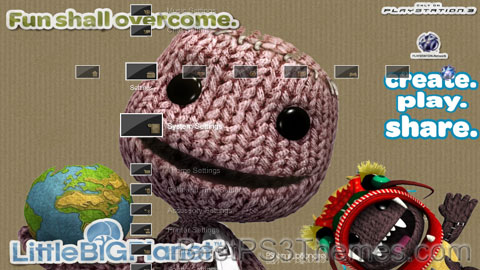
(3 backgrounds)
| LittleBigPlanet | |
|---|---|
 | |
| Genre(s) | Platform, endless running |
| Developer(s) | Media Molecule (2008-2014) SCE Studio Cambridge (2009) Supermassive Games (2010) XDev (2010-2012) Double Eleven (2012) Tarsier Studios (2012) United Front Games (2012) San Diego Studio (2012) Firesprite (2014) Sumo Digital (2014-2020) Exient Entertainment (2023) |
| Publisher(s) | Sony Interactive Entertainment PlayStation Mobile (2014) |
| Platform(s) | PlayStation 3 PlayStation Portable PlayStation Vita PlayStation 4 PlayStation 5 Windows |
| First release | LittleBigPlanet 27 October 2008 |
| Latest release | Ultimate Sackboy March 3, 2023 |
LittleBigPlanet (LBP - stylised as LittleBIGPlanet) is a puzzle platform video game series created and produced by British developer Media Molecule and published by Sony Interactive Entertainment. Most games in the series put a strong emphasis on user-generated content and are based on the series' tagline "Play, Create, Share". The tagline represents the three core elements of the series: playing alone or with others locally (on the same console) or online, creating new content using the in-game creation tools, and sharing creations and discoveries online with other players.
Tarsier Studios, Fireproof Games and Supermassive Games also contribute to the development of the PlayStation 3 games, creating in-game assets (downloadable content) including costumes, backgrounds, objects, and stickers. Some of these assets will also provide the player more tools and gadgets to use in the level editor.[1]
The series comprises six games across five gaming platforms. The series was launched in 2008 with the PlayStation 3 game LittleBigPlanet, which was followed in 2009 by a PlayStation Portable version of the same name, initially developed by Studio Liverpool[2] and later handed to SCE Studio Cambridge. The sequel to the PlayStation 3 version, LittleBigPlanet 2, was released in January 2011 alongside a smaller spin-off title called Sackboy's Prehistoric Moves. LittleBigPlanet PS Vita was developed by Tarsier Studios and Double Eleven, released in September 2012 for the PlayStation Vita. At E3 2014, Sony announced LittleBigPlanet 3, a PlayStation 4 instalment that was developed by Sumo Digital and released in November 2014.[3] The games are all published by Sony Computer Entertainment. The latest instalment for the LittleBigPlanet franchise titled Sackboy: A Big Adventure was revealed during the PS5 live event and released on the PlayStation 4 and PlayStation 5 in November 2020. A Windows version was released on 27 October 2022.[4]
On 17 January 2015, it was announced that all LittleBigPlanet servers in Japan would shut down on 31 July, along with the PlayStation Portable version and LittleBigPlanet Karting in late August in all regions. Due to attacks on the online servers, all LittleBigPlanet servers were taken down in May 2021 (the Vita version had remained closed since March).[5] The servers for the PS4 version of LittleBigPlanet 3 were brought back up on 13 September 2021, however, in the same announcement, it mentioned that the servers for LittleBigPlanet, LittleBigPlanet 2, LittleBigPlanet PS Vita and the PS3 version of LittleBigPlanet 3 will remain closed permanently.[6] On 8 January, 2024, it was announced that, presumably due to more attacks on the online servers, the servers for the PS4 version of LittleBigPlanet 3 were being temporarily closed while they investigate them.[7][8][9]
On 19 April 2024, the servers for the PlayStation 4 version of LittleBigPlanet 3 were permanently shut down due to ongoing technical issues.[10]
The core mechanics of the series revolve around its tagline, "Play, Create, Share".[11]
In the first two instalments of the series, gameplay consist primarily of traditional two-dimensional look in a three-dimensional style platforming like jumping and avoiding obstacles to successfully navigate to the end of a level to win.[12] Since LittleBigPlanet 2, the series has included mini-games, including ones that do not follow the platformer genre. Most LittleBigPlanet games involve a player playing solo or co-operatively with friends to navigate through a level whilst collecting various "bubbles" along the way, which can take the form of either points or collectibles. In-game collectibles can be used in level creation or to customize Sackboy, the player character. There are also numerous co-operative parts of levels whereby certain prize bubbles can be earned. In LittleBigPlanet 3 and Sackboy: A Big Adventure, Collectables are also present, being used in various shops to purchase more costumes.
The Create component primarily refers to level creation in the game, along with other features like character customisation. Players can create their own levels with the built-in level creator. Many items that are collected while playing through the story mode and from LittleBigPlanet's community can be used to help with level creation.[13] These levels can remain as the original LittleBigPlanet platforming gameplay, or they can include other game types, such as racing, fighting, shooting and sports.[12] The player can also make non-gaming creations such as music and films (commonly known in-game as cut-scenes).[14] In LittleBigPlanet 2, Sackbots were introduced to give players more control over non-player characters in their levels as well as make the levels in their entirety more intelligent. The creation technique introduced on the game gave the possibility for logic, and it gave the ability to build sets of machines and complex contraptions.[14]
Lastly, the Share component relates to sharing creations with the game's community by uploading levels to the PlayStation Network. To-date there were an excess of ten million user-created levels available to play on the LittleBigPlanet server in the PlayStation 3 games.[15] After the release of LittleBigPlanet 2 and the LBP.me community website, the Share component also had a strong emphasis sharing discoveries. Players were encouraged to share levels they found with other players by writing reviews and comments in-game and by sharing links to creations' LBP.me pages via social networks.
The series takes place in a world known as LittleBigPlanet. Each curator is in charge of a part of LittleBigPlanet and they govern them independently. LittleBigPlanet has geography inspired by the real-life Earth. All games in the series follow the main protagonist Sackboy, a small anthropomorphic creature made of brown fabric with a zip fastener and button eyes. He can be customized to the player's liking using costumes that are either unlocked in the game or bought as downloadable content from the PlayStation Store. The player can control Sackboy's four emotions; happiness, sadness, worry and anger, each of which has three levels of intensity. The English language version of each game is narrated by Stephen Fry and in all formats Fry's scripts are written by Dean Wilkinson.
| 2008 | LittleBigPlanet |
|---|---|
| 2009 | LittleBigPlanet (PSP) |
| 2010 | Sackboy's Prehistoric Moves |
| 2011 | LittleBigPlanet 2 |
| 2012 | LittleBigPlanet PS Vita |
| LittleBigPlanet Karting | |
| 2013 | |
| 2014 | Run Sackboy! Run! |
| LittleBigPlanet 3 | |
| 2015 | |
| 2016 | |
| 2017 | |
| 2018 | |
| 2019 | |
| 2020 | Sackboy: A Big Adventure |
| 2021 | |
| 2022 | |
| 2023 | Ultimate Sackboy |
The first game in the series was released on the PlayStation 3 platform in 2008 and was the first title developed by Media Molecule, under the name The Next Big Thing. The player controls Sackboy as he travels around the titular LittleBigPlanet, helping the eight creator curators of LittleBigPlanet with their problems in their own respective realms. Throughout the story, Sackboy tries to stop The Collector, one of the eight creator curators who has gone rogue, kidnapping the creations of LittleBigPlanet.[16] The game received widespread acclaim for its design, gameplay, and customization afforded to the player, particularly the built-in level editor. After its release, it received numerous industry awards.[17]
The second game in the series is a direct sequel to the first LittleBigPlanet and was developed by Media Molecule for the PlayStation 3 for a release in 2011. The sequel saw a major shift in the direction of the series, going from a primarily traditional platform game in the first two entries to a more varied style of gameplay called a "platform for games". The second game gave players a wider variety of options when it came to level design, which saw the creation of levels other than platforming such as racing, puzzles, and fighting games.[18] Following the events of the first two entries in the series, the game takes place when an antagonist known as the Negativitron invades LittleBigPlanet and begins to suck up all its inhabitants. Sackboy must team up with a secret organization known as "The Alliance", led by Larry Da Vinci, to save LittleBigPlanet from the Negativitron.[19] The game also supported the PlayStation Move, with an update post-launch.
LittleBigPlanet 3 is a game for the PlayStation 3[20][21][22] and PlayStation 4. Announced at E3 2014, it was developed by Sumo Digital and was released in November 2014. In the game, Sackboy is transported to another world, Bunkum, where he has to awaken its three missing heroes, OddSock, Toggle and Swoop, who are new playable characters. Sackboy travels through different worlds in order to free the 3 new characters and stop Newton.[23]
A portable entry of the series was developed primarily by SCE Studio Cambridge in association with Media Molecule for the PlayStation Portable. The game, released in 2009, shared the same name as the original game; however, it was not a port of the PlayStation 3 game, but rather a new entry in the series. It has a story-mode with levels and features many of the same mechanics of its PlayStation 3 counterpart, such as customizations, albeit without the multiplayer component of the game. The game takes place after the events of the PlayStation 3 version of LittleBigPlanet, in which The Collector has been defeated. A carnival is being held and Sackboy decides to go around the world to invite the eight curators of LittleBigPlanet to the carnival whilst finding materials for his own carnival float.[24]
The fourth game in the series was developed by Tarsier Studios, Double Eleven, and XDev for the PlayStation Vita handheld and had a 2012 release.[25] The game features the same core mechanics from LittleBigPlanet 2, with the focus being on a "platform for games" rather than a platformer like previous entries in the series before LittleBigPlanet 2. The game utilizes the unique controls of the PlayStation Vita by using its multi-touch touchscreen and its rear touchpad to navigate through various obstacles in stages as well as for level creation by users.[26] The game supports cross-buy of DLC costume packs between LittleBigPlanet 2, as well as LittleBigPlanet Karting.
LittleBigPlanet Karting is a kart racing game developed by United Front and San Diego Studio in conjunction with series creator Media Molecule for the PlayStation 3.[27] In its story mode, the player ventures through worlds including: LittleBigPlanet, Monster Islands, Victoria's Laboratory, The Progress Emporium, Eve's Asylum, The Space Bass, and Hoard, Sweet Hoard, to put an end to the Hoard racers, who snatch many pieces of the different planets to stash them in the Garage at the End of the Universe. Sony Entertainment America shut down the North American LittleBigPlanet Karting online servers on 31 August 2016.[28]
The game was developed by XDev as a spin-off from the LittleBigPlanet series utilizing the PlayStation Move on the PlayStation 3. It was released in December 2010, as a downloadable title from the PlayStation Store and was later bundled with LittleBigPlanet 2. The game was described as a "demo" and featured 10 prehistoric inspired story levels. In the game, Sackboy must save Little Big Planet from the T-Rex. Unlike the main games, which can be played as a single-player experience, the game required a minimum of two players to work.[29] This was due to the main mechanics of the spin-off whereby one player would control Sackboy traditionally using the gamepad for platforming while a second player had to use a PlayStation Move similar to a pointer to move obstacles and objects out of the way in order to successfully navigate a level.[30]
Run Sackboy! Run! is a free-to-play endless running game developed by Firesprite and published by PlayStation Mobile that was released on iOS on 30 October 2014,[31] Android on 17 December 2014[32] and PlayStation Vita on 31 March 2015.[33] The game has no real plot, except for Sackboy running through Craftworld from the Negativitron. The game awarded players with exclusive costumes for LittleBigPlanet 3 (which was released at a similar time) by reaching point goals and collecting stickers.[34]
LittleBigPlanet Hub is an unreleased free-to-play game for the PlayStation 3.[35] It was planned to be a downloadable title from the PlayStation Store which would have allowed players to create levels and play a curated selection of community levels from LittleBigPlanet and LittleBigPlanet 2 as well as 16 levels from the games' story modes. LittleBigPlanet Hub would also have contained weekly challenges, not found in other LittleBigPlanet games. Downloadable content purchased in other games were to be compatible with LittleBigPlanet Hub, and users were rumoured to be also able to access additional content from the PlayStation Store.[citation needed]
Since its announcement in August 2013, no further details about LittleBigPlanet Hub were revealed.[36] In February 2024, a beta tester posted a video showing gameplay from a beta build onto YouTube, and shortly afterwards, with assistance, dumped it online for download. This makes the build playable through unofficial means, such as emulations like RPCS3 or PlayStation 3 homebrew.[37]
Sackboy: A Big Adventure is a 2020 platform game developed by Sumo Digital and published by Sony Interactive Entertainment for the PlayStation 5 and the PlayStation 4. It was announced at the PlayStation 5 reveal event on June 11, 2020, and was released on November 12, 2020; a version for Windows was released on October 27, 2022, marking the series's first release on PCs. Unlike previous LittleBigPlanet entries with 2.5D platforming, A Big Adventure features a range of perspectives and 3D movement.
Ultimate Sackboy is a free-to-play endless running game developed by Exient Entertainment and released on mobile on 21 February 2023. It is the first LittleBigPlanet game to feature limited-time paid subscriptions known as "Marathons." In contrast to Run Sackboy! Run!, it adopts the style from Sackboy: A Big Adventure and is played in 3D.
| Game | Metacritic |
|---|---|
| LittleBigPlanet (PlayStation 3) | 95/100[38] |
| LittleBigPlanet (PlayStation Portable) | 87/100[39] |
| Sackboy's Prehistoric Moves | 66/100[40] |
| LittleBigPlanet 2 | 91/100[41] |
| LittleBigPlanet PS Vita | 88/100[42] |
| LittleBigPlanet Karting | 74/100[43] |
| LittleBigPlanet 3 | 79/100[44] |
| Run Sackboy! Run! | 65/100[45] |
| Sackboy: A Big Adventure | 80/100[46] |
| Ultimate Sackboy | 57/100[47] |
Most of the games in the series have been well received by critics with the LittleBigPlanet on PlayStation 3 and PlayStation Portable gaining Metacritic scores of 95/100[38] and 87/100[39] respectively. LittleBigPlanet 2 garnered nearly as much acclaim as the first game, with an average score of 91/100.[48] LittleBigPlanet PS Vita also received very positive reviews and was the highest-ranked PS Vita game at the time of its release with an average score of 88/100.[49] However, the release of LittleBigPlanet 3 did not receive critical acclaim, garnering a mostly positive average of 79/100.[50] Critically, LittleBigPlanet Karting is the worst-performing major game in the series so far but still gained a "mixed or average" Metacritic score of 74/100.[51] However, the mobile game Run Sackboy! Run! performed worse, with a Metacritic score of 65/100.[52] Additionally, the character of Sackboy is often seen as a PlayStation mascot.[53] In 2011, readers of Guinness World Records Gamer's Edition voted Sackboy as the 50th-top video game character of all time.[54]
Domokun Rockstar theme by charlie99887
Download: DomoKunRockstar.p3t
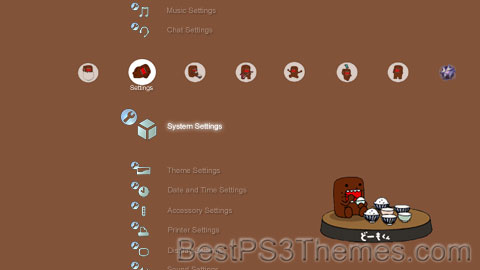
(2 backgrounds)
P3T Unpacker v0.12
Copyright (c) 2007. Anoop Menon
This program unpacks Playstation 3 Theme files (.p3t) so that you can touch-up an existing theme to your likings or use a certain wallpaper from it (as many themes have multiple). But remember, if you use content from another theme and release it, be sure to give credit!
Download for Windows: p3textractor.zip
Instructions:
Download p3textractor.zip from above. Extract the files to a folder with a program such as WinZip or WinRAR. Now there are multiple ways to extract the theme.
The first way is to simply open the p3t file with p3textractor.exe. If you don’t know how to do this, right click the p3t file and select Open With. Alternatively, open the p3t file and it will ask you to select a program to open with. Click Browse and find p3textractor.exe from where you previously extracted it to. It will open CMD and extract the theme to extracted.[filename]. After that, all you need to do for any future p3t files is open them and it will extract.
The second way is very simple. Just drag the p3t file to p3textractor.exe. It will open CMD and extract the theme to extracted.[filename].
For the third way, first put the p3t file you want to extract into the same folder as p3textractor.exe. Open CMD and browse to the folder with p3extractor.exe. Enter the following:
p3textractor filename.p3t [destination path]Replace filename with the name of the p3t file, and replace [destination path] with the name of the folder you want the files to be extracted to. A destination path is not required. By default it will extract to extracted.filename.
Nintendo World theme by Potts2k8
Download: NintendoWorld.p3t
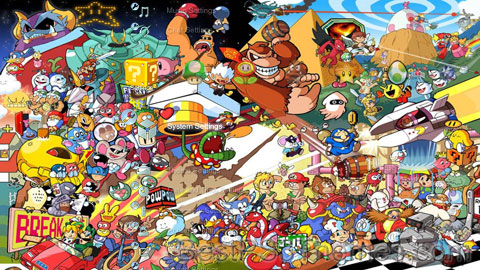
(1 background)
This article needs additional citations for verification. (February 2017) |
| Editor | Editora Tambor |
|---|---|
| Categories | Video game magazine |
| Publisher | Conrad Editora |
| First issue | 1998 |
| Country | Brazil |
| Website | nintendoworld |
Nintendo World is a Brazilian video game magazine,[1] which covers games for the Nintendo Wii, Wii U, 3DS and DS. It was created in 1998 by the Conrad Editora. Initially it covered games for the Nintendo 64 and Game Boy Color consoles, which were very popular in the country at the time and were distributed in the country by the Estrela/Gradiente joint-venture. Over 100 issues have been published as of 2006, and the magazine has been awarded by Nintendo of America for its high readership and for being one of the best quality Nintendo magazines in Latin America. Its current editor is Editora Tambor. From issue 60 onwards, the magazine started featuring content from Nintendo Power.
Civic Si New theme by TTownEP
Download: CivicSiNew.p3t
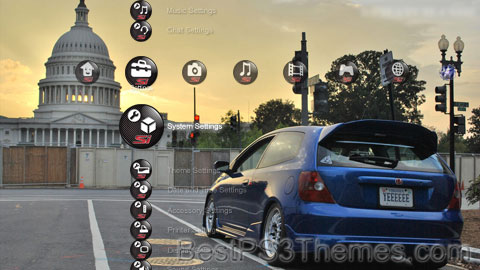
(9 backgrounds)
P3T Unpacker v0.12
Copyright (c) 2007. Anoop Menon
This program unpacks Playstation 3 Theme files (.p3t) so that you can touch-up an existing theme to your likings or use a certain wallpaper from it (as many themes have multiple). But remember, if you use content from another theme and release it, be sure to give credit!
Download for Windows: p3textractor.zip
Instructions:
Download p3textractor.zip from above. Extract the files to a folder with a program such as WinZip or WinRAR. Now there are multiple ways to extract the theme.
The first way is to simply open the p3t file with p3textractor.exe. If you don’t know how to do this, right click the p3t file and select Open With. Alternatively, open the p3t file and it will ask you to select a program to open with. Click Browse and find p3textractor.exe from where you previously extracted it to. It will open CMD and extract the theme to extracted.[filename]. After that, all you need to do for any future p3t files is open them and it will extract.
The second way is very simple. Just drag the p3t file to p3textractor.exe. It will open CMD and extract the theme to extracted.[filename].
For the third way, first put the p3t file you want to extract into the same folder as p3textractor.exe. Open CMD and browse to the folder with p3extractor.exe. Enter the following:
p3textractor filename.p3t [destination path]Replace filename with the name of the p3t file, and replace [destination path] with the name of the folder you want the files to be extracted to. A destination path is not required. By default it will extract to extracted.filename.
AS Roma theme by fuexakaalex
Download: ASRoma_2.p3t
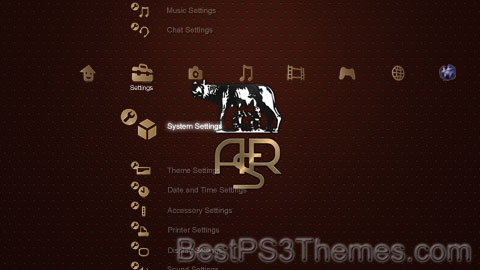
(1 background)
 | ||||
| Full name | Associazione Sportiva Roma S.p.A. | |||
|---|---|---|---|---|
| Nickname(s) | I Giallorossi (The Yellow and Reds) La Lupa (The She-Wolf) La Magica (The Magic One) Capitolini (Capitoline) Lupetti (Little Cubs) Lupi (Wolves) | |||
| Founded | 7 June 1927 (as Italo Foschi) | |||
| Ground | Stadio Olimpico | |||
| Capacity | 70,634[1] | |||
| Owner | The Friedkin Group (95.97%) | |||
| President | Dan Friedkin | |||
| Head coach | Daniele De Rossi | |||
| League | Serie A | |||
| 2023–24 | Serie A, 6th of 20 | |||
| Website | Club website | |||
|
| ||||
Associazione Sportiva Roma (Rome Sport Association; Italian pronunciation: [ˈroːma]) is a professional football club based in Rome, Italy. Founded by a merger in 1927, Roma has participated in the top tier of Italian football for all of its existence, except for the 1951–52 season. Roma has won Serie A three times, in 1941–42, 1982–83 and 2000–01, as well as nine Coppa Italia titles and two Supercoppa Italiana titles. In European competitions, Roma won the Inter-Cities Fairs Cup in 1960–61 and the UEFA Europa Conference League in 2021–22, while they finished runners-up in the 1983–84 European Cup, the 1990–91 UEFA Cup and the 2022–23 UEFA Europa League.
Sixteen players have won the FIFA World Cup while playing at Roma: Attilio Ferraris and Enrique Guaita (1934); Guido Masetti and Eraldo Monzeglio (1934 and 1938); Aldo Donati and Pietro Serantoni (1938); Bruno Conti (1982); Rudi Völler and Thomas Berthold (1990); Aldair (1994); Vincent Candela (1998); Cafu (2002); Daniele De Rossi, Simone Perrotta and Francesco Totti (2006); Paulo Dybala (2022).
Since 1953, Roma has played home matches at the Stadio Olimpico, a venue the club shares with city rivals Lazio. With a capacity of over 72,000, the stadium is the second-largest of its kind in Italy, with only the San Siro able to seat more. The club plans to move to a new stadium, though it is yet to start construction. Having a strong local rivalry, Roma and Lazio contest the Derby della Capitale.
The club's home colours are carmine red and golden yellow, which gives Roma its nickname "I Giallorossi" ("The Yellow and Reds"). These colours have often been combined with white shorts. The club badge features a she-wolf, an allusion to the founding myth of Rome.

AS Roma was founded in the spring of 1927 when Italo Foschi[2] initiated the merger of three older Italian Football Championship clubs from the city of Rome: Roman FC, SS Alba-Audace and Fortitudo-Pro Roma SGS.[2] Foschi was an important Roman representative of the ruling National Fascist Party.[3][4]
The purpose of the merger was to give the Italian capital a strong club to rival that of the more dominant Northern Italian clubs of the time.[2] The only major Roman club to resist the merger was Lazio because of the intervention of the army General Vaccaro, a member of the club and executive of Italian Football Federation (FIGC). All three founding clubs were relegated, but the fascist-aligned FIGC bet over the capacity of the new team to give a stronger representation to the capital of Italy, and they were awarded a wild card for the Divisione Nazionale, the Serie A forerunner. The club played its earliest seasons at the Motovelodromo Appio stadium,[5] before settling in the working-class streets of Testaccio, where it built an all-wooden ground Campo Testaccio; this was opened in November 1929.[6] An early season in which Roma made a large mark was the 1930–31 championship, where the club finished as runners-up behind Juventus.[7] Captain Attilio Ferraris, along with Guido Masetti, Fulvio Bernardini and Rodolfo Volk, were highly important players during this period.[8]

After a slump in league form and the departure of high key players, Roma eventually rebuilt their squad, adding goalscorers such as the Argentine Enrique Guaita.[9] Under the management of Luigi Barbesino, the Roman club came close to their first title in 1935–36, finishing just one point behind champions Bologna.[10]
Roma returned to form after being inconsistent for much of the late 1930s. Roma recorded an unexpected title triumph in the 1941–42 season by winning their first scudetto title.[11] The 18 goals scored by local player Amedeo Amadei were essential to the Alfréd Schaffer-coached Roma side winning the title. At the time, Italy was involved in World War II and Roma were playing at the Stadio Nazionale PNF.[12]
In the years just after the war, Roma were unable to recapture their league stature from the early 1940s. Roma finished in the lower half of Serie A for five seasons in a row, before eventually succumbing to their only ever relegation to Serie B at the end of the 1950–51 season,[7][13] around a decade after their championship victory. Under future Italy national team manager Giuseppe Viani, promotion straight back up was achieved.[14]
After returning to the Serie A, Roma managed to stabilise themselves as a top-half club again with players such as Egisto Pandolfini, Dino da Costa and Dane Helge Bronée.[7] Their best finish of this period was under the management of Englishman Jesse Carver, when in 1954–55, they finished as runners-up after Udinese, who originally finished second, were relegated for corruption.[7] Although Roma were unable to break into the top four during the following decade, they did achieve some measure of cup success. Their first honour outside of Italy was recorded in 1960–61 when Roma won the Inter-Cities Fairs Cup by defeating Birmingham City 4–2 in the finals.[15] A few years later, Roma won their first Coppa Italia trophy in 1963–64 after defeating Torino 1–0.[16]
Their lowest point came during the 1964–65 season, when manager Juan Carlos Lorenzo announced the club could not pay its players and was unlikely to be able to afford to travel to Vicenza to fulfil its next fixture. Supporters kept the club going with a fundraiser at the Sistine Theatre and bankruptcy was avoided with the election of a new club president Franco Evangelisti.
Their second Coppa Italia trophy was won in 1968–69, when it competed in a small, league-like system.[16] Giacomo Losi set a Roma appearance record in 1969 with 450 appearances in all competitions, a record that would last 38 years.[17]

Roma were able to add another cup to their collection in 1972, with a 3–1 victory over Blackpool in the Anglo-Italian Cup.[18] During much of the 1970s, Roma's appearance in the top half of Serie A was sporadic. The best place the club were able to achieve during the decade was third in 1974–75.[7] Notable players who turned out for the club during this period included midfielders Giancarlo De Sisti and Francesco Rocca.
The dawning of a newly successful era in Roma's footballing history was brought in with another Coppa Italia victory; they defeated Torino on penalties to win the 1979–80 edition.[16] Roma would reach heights in the league which they had not touched since the 1940s by narrowly and controversially finishing as runners-up to Juventus in 1980–81.[19] Former Milan player Nils Liedholm was the manager at the time, with players such as Bruno Conti, Agostino Di Bartolomei, Roberto Pruzzo and Falcão.[20]
The second scudetto did not elude Roma for much longer. In 1982–83, the Roman club won the title for the first time in 41 years, amidst celebrations in the capital.[21] The following season, Roma finished as runners-up in Italy[7] and collected a Coppa Italia title;[16] they also finished as runners-up in the European Cup final of 1984.[22] The European Cup final with Liverpool ended in a 1–1 draw with a goal from Pruzzo, but Roma eventually lost in the penalty shoot-out.[22] Roma's successful run in the 1980s would finish with a runners-up spot in 1985–86[7] and a Coppa Italia victory, beating out Sampdoria 3–2.[16]
After, a comparative decline began in the league, one of the few league highs from the following period being a third-place finish in 1987–88.[7] At the start of the 1990s, the club was involved in an all-Italian UEFA Cup final, where they lost 2–1 to Internazionale in 1991.[23] The same season, the club won its seventh Coppa Italia[16] and ended runners-up to Sampdoria in the Supercoppa Italiana. Aside from finishing runners-up to Torino in a Coppa Italia final,[16] the rest of the decade was largely sub-par in the history of Roma, particularly in the league, where the highest they could manage was fourth in 1997–98.[7] The early 1990s also saw the emergence of homegrown striker Francesco Totti, who would go on to be an important member of the team and the club's iconic captain.
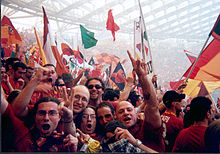
Roma won their third Serie A title in 2000–01. The Scudetto was won on the last day of the season after defeating Parma 3–1, edging Juventus by two points.[7] The club's captain, Francesco Totti, was a large reason for the title victory and he would become one of the main heroes in the club's history,[20] going on to break several club records.[20] Other important players during this period included: Aldair, Cafu, Gabriel Batistuta and Vincenzo Montella.[24]
In the 2001–02 Serie A, Roma ended as runners-up to Juventus by one point.[7] This would be the start of Roma finishing as runners-up several times in both Serie A and Coppa Italia during the 2000s – they lost out 4–2 to Milan in the Coppa Italia final of 2003[16] and lost to Milan again by finishing second in Serie A for the 2003–04 season.[7] The club also re-capitalized several time in 2003–04 season. In November 2003, €37.5 million was injected by "Roma 2000" to cover the half-year loss and loss carried from previous year.[25] and again on 30 June for €44.57 million.[26] Through stock market, a further €19.850 million of new shares issued, and at the year end, the share capital was €19.878 million,[27] which was unchanged as of 2011[update]. The following season also saw the departure of Walter Samuel for €25 million and Emerson for €28 million, which decreased the strength of the squad. The Giallorossi finished in eighth place, one of the worst of recent seasons.

On 9 July 2006, Roma's Francesco Totti, Daniele De Rossi and Simone Perrotta were part of the Italy national team which defeated France in the 2006 FIFA World Cup Final.[28] In the Calciopoli scandal of 2006, Roma were not one of the teams involved. After punishments were issued, Roma was re-classified as runners-up for 2005–06,[29] the same season they finished second in the Coppa Italia losing to Internazionale.[16] In the two following seasons, 2006–07 and 2007–08, Roma finished as Serie A runners-up, meaning that in the 2000s, Roma finished in the top two positions more than any other decade in their history.[30] Meanwhile, in the UEFA Champions League during both of these seasons, they reached the quarter-finals before going out to Manchester United. In the 2008–09 Champions League, Roma reached the knockout stage ahead of Chelsea in their group, thus finishing for the first time in their history as winners of the group stage. However, they lost to Arsenal in the knockout stage on penalty kicks.
After a disappointing start to the 2009–10 season, Claudio Ranieri replaced Luciano Spalletti as head coach. At the time of the switch, Roma lay bottom of the Serie A table after losses to Juventus and Genoa. Despite this setback, Roma went on unbeaten streak of 24 matches in the league – with the last of the 24 being a 2–1 win over rivals Lazio, whereby they came from 1–0 down at half-time to defeat their city rivals after Ranieri substituted both Totti and De Rossi at the interval.[31] The Giallorossi were on top of the table at one point, before a loss to Sampdoria later in the season. Roma would finish runners-up to Internazionale yet again in both Serie A and the Coppa Italia. During the 2000s, Roma had finally recaptured the Scudetto, two Coppa Italia trophies, and their first two Supercoppa Italiana titles. Other notable contributions to the club's history have included a return to the Champions League quarter-finals (in the 2006–07 and 2007–08 editions) since 1984, six runners up positions in the league, four Coppa Italia finals and three Supercoppa finals – marking Roma's greatest ever decade.
KSA(10) theme by XDA_WALEED
Download: KSA10.p3t
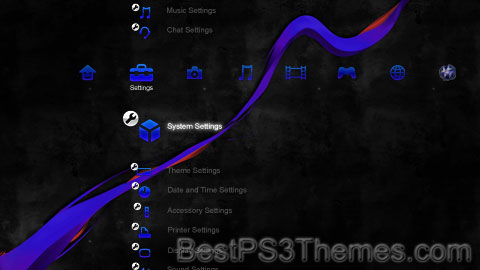
(1 background)
P3T Unpacker v0.12
Copyright (c) 2007. Anoop Menon
This program unpacks Playstation 3 Theme files (.p3t) so that you can touch-up an existing theme to your likings or use a certain wallpaper from it (as many themes have multiple). But remember, if you use content from another theme and release it, be sure to give credit!
Download for Windows: p3textractor.zip
Instructions:
Download p3textractor.zip from above. Extract the files to a folder with a program such as WinZip or WinRAR. Now there are multiple ways to extract the theme.
The first way is to simply open the p3t file with p3textractor.exe. If you don’t know how to do this, right click the p3t file and select Open With. Alternatively, open the p3t file and it will ask you to select a program to open with. Click Browse and find p3textractor.exe from where you previously extracted it to. It will open CMD and extract the theme to extracted.[filename]. After that, all you need to do for any future p3t files is open them and it will extract.
The second way is very simple. Just drag the p3t file to p3textractor.exe. It will open CMD and extract the theme to extracted.[filename].
For the third way, first put the p3t file you want to extract into the same folder as p3textractor.exe. Open CMD and browse to the folder with p3extractor.exe. Enter the following:
p3textractor filename.p3t [destination path]Replace filename with the name of the p3t file, and replace [destination path] with the name of the folder you want the files to be extracted to. A destination path is not required. By default it will extract to extracted.filename.
WoodGrainChrome theme by Matt8107t
Download: WoodGrainChrome.p3t
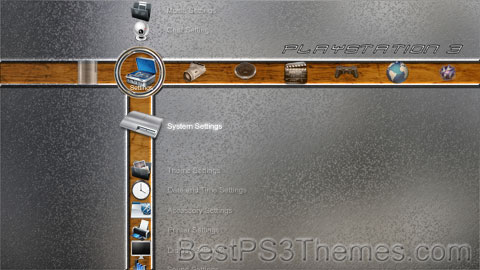
(2 backgrounds)
P3T Unpacker v0.12
Copyright (c) 2007. Anoop Menon
This program unpacks Playstation 3 Theme files (.p3t) so that you can touch-up an existing theme to your likings or use a certain wallpaper from it (as many themes have multiple). But remember, if you use content from another theme and release it, be sure to give credit!
Download for Windows: p3textractor.zip
Instructions:
Download p3textractor.zip from above. Extract the files to a folder with a program such as WinZip or WinRAR. Now there are multiple ways to extract the theme.
The first way is to simply open the p3t file with p3textractor.exe. If you don’t know how to do this, right click the p3t file and select Open With. Alternatively, open the p3t file and it will ask you to select a program to open with. Click Browse and find p3textractor.exe from where you previously extracted it to. It will open CMD and extract the theme to extracted.[filename]. After that, all you need to do for any future p3t files is open them and it will extract.
The second way is very simple. Just drag the p3t file to p3textractor.exe. It will open CMD and extract the theme to extracted.[filename].
For the third way, first put the p3t file you want to extract into the same folder as p3textractor.exe. Open CMD and browse to the folder with p3extractor.exe. Enter the following:
p3textractor filename.p3t [destination path]Replace filename with the name of the p3t file, and replace [destination path] with the name of the folder you want the files to be extracted to. A destination path is not required. By default it will extract to extracted.filename.
New PSN theme by CpnNemo
Download: NewPSN.p3t
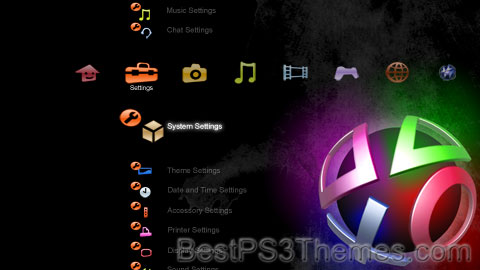
(1 background)
P3T Unpacker v0.12
Copyright (c) 2007. Anoop Menon
This program unpacks Playstation 3 Theme files (.p3t) so that you can touch-up an existing theme to your likings or use a certain wallpaper from it (as many themes have multiple). But remember, if you use content from another theme and release it, be sure to give credit!
Download for Windows: p3textractor.zip
Instructions:
Download p3textractor.zip from above. Extract the files to a folder with a program such as WinZip or WinRAR. Now there are multiple ways to extract the theme.
The first way is to simply open the p3t file with p3textractor.exe. If you don’t know how to do this, right click the p3t file and select Open With. Alternatively, open the p3t file and it will ask you to select a program to open with. Click Browse and find p3textractor.exe from where you previously extracted it to. It will open CMD and extract the theme to extracted.[filename]. After that, all you need to do for any future p3t files is open them and it will extract.
The second way is very simple. Just drag the p3t file to p3textractor.exe. It will open CMD and extract the theme to extracted.[filename].
For the third way, first put the p3t file you want to extract into the same folder as p3textractor.exe. Open CMD and browse to the folder with p3extractor.exe. Enter the following:
p3textractor filename.p3t [destination path]Replace filename with the name of the p3t file, and replace [destination path] with the name of the folder you want the files to be extracted to. A destination path is not required. By default it will extract to extracted.filename.